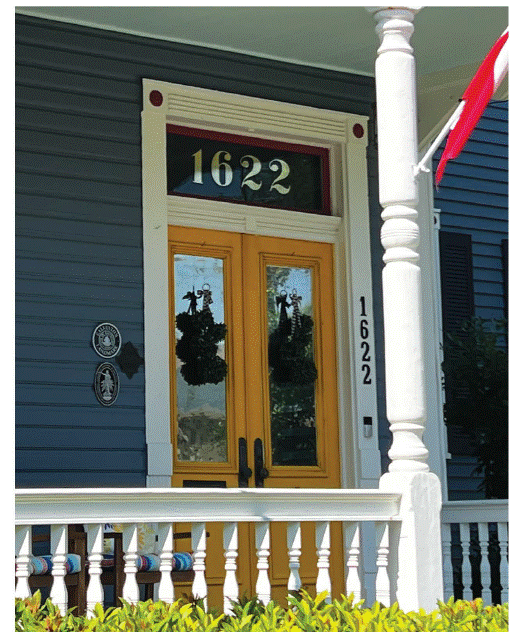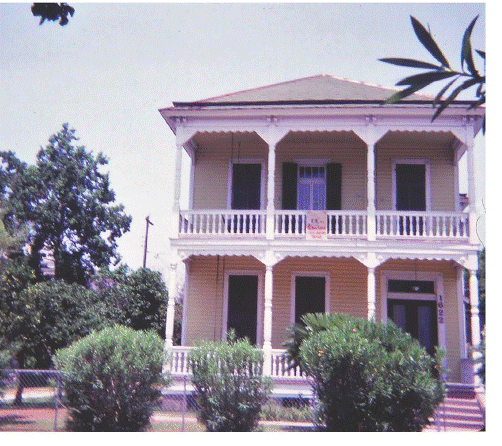The double-galleried Greek Revival home at 1622 Ball Street stands as a testament to both ambition and resilience in nineteenth-century Galveston. It was built for George W. Trapp (1825-1896), a Bavarian immigrant who rose from clerk to prominent merchant and civic leader.
On Christmas Day 1860, Trapp married Austrian-born Babette Somerherr (1835-1910), just two months after becoming a naturalized citizen. At the time, he was working as a clerk for Morris Kopperl, a fellow immigrant who would also rise to prominence in Galveston.
When Kopperl’s senior business partner died in 1865, Trapp took over the firm and launched his own general merchandise and cotton factorage business.
He opened in the brick Osterman Building at 22nd Street and The Strand in August of that year - just two months after General Gordon Granger had read General Orders No. 3 from the same building, declaring freedom for all enslaved people in Texas.
From his new office, the young entrepreneur sold everything from cigars to buggies, steadily building a solid reputation. By 1870, after earning the community’s respect, Trapp was appointed Collector and Assessor for the County Court.
Six years later, he resumed working directly with Kopperl in a cotton factor and commission merchant business housed in the Hendley Building. The two men soon became fellow directors of the Texas National Bank and emerged as two of Galveston’s most influential businessmen.
 Trapp’s success enabled him and his wife to build a home at 1622 Ball Street, valued at $2,500. According to the 1880 census, the household included the couple, a 23-year-old servant named Minnie Lohman, and a boarder - widower Dr. John H. Coers.
Trapp’s success enabled him and his wife to build a home at 1622 Ball Street, valued at $2,500. According to the 1880 census, the household included the couple, a 23-year-old servant named Minnie Lohman, and a boarder - widower Dr. John H. Coers.
Tragedy struck in November 1885 when the Great Galveston Fire ignited at the Vulcan Iron Works Foundry on The Strand, consuming 42 city blocks between 16th and 19th Streets - from The Strand all the way to the Gulf. The Trapp home was among the hundreds of residences lost in the blaze.
Undeterred, the family rebuilt. By 1886, their new residence - valued at $3,000 - stood proudly on the same site. The 1889 Sanborn Fire Insurance map recorded its full-length front porch and three smaller outbuildings at the rear of the property.
The home’s ornate Gothic carpentry canopy above a side entrance, along with millwork featuring traditional God’s-eye motifs, reflected a distinctly European influence.
The Trapp home was crafted with a keen eye for both elegance and practicality. Hand-shaped balusters lined the staircase, and large pocket doors opened into a front parlor designed to impress any visitor who crossed the threshold. The butler’s pantry extended the home’s decorative theme, featuring circular motifs that echoed those on the façade.
Inside, refinement met function. In the music room, an imported marble mantel crowned the coal-burning fireplace - a feature mirrored upstairs in the bedroom suite. Even storage was thoughtfully considered, with a closet tucked beneath the stairs and two clothing closets flanking the second-floor bedroom.
 By the following year, the Trapps were listed in the city directory as residents of their newly rebuilt home. Ernestina Wunsch joined the household, replacing Minnie Lohman as their live-in servant and remaining with the couple for two years.
By the following year, the Trapps were listed in the city directory as residents of their newly rebuilt home. Ernestina Wunsch joined the household, replacing Minnie Lohman as their live-in servant and remaining with the couple for two years.
A more lasting change came with the arrival of 17-year-old Florence Marchal (1871-1918), a recent immigrant from Belgium who began working for the Trapps in 1888.
Her parents’ records are scarce, and it’s possible she came to America alone or was recommended to the family by an acquaintance in Belgium. Within two years, Florence became the household’s sole live-in help.
George passed away on January 19, 1896, at the age of 70, leaving Babette and Florence alone in the Ball Street home. His funeral was held there the following afternoon, and that October, a trust sale of his real estate holdings - excluding the residence - took place on the courthouse steps.
In the quiet that followed, Babette, then in her sixties and childless, appeared to grow especially close to Florence. By age 25, Florence was no longer listed as an employee in city directories or census records. She was likely considered part of the family.
In the years following George’s death, Babette oversaw several improvements to the home, including the addition of a second-story side gallery on the west side. She and Florence continued living alone until 1900, when Babette welcomed a boarder, Charles E. Solomon.
An English immigrant employed at Blum Hardware, Solomon stayed only a year, leaving Galveston after the devastating 1900 Storm. In Houston, he quickly rose to prominence - first as president of the Janke Music Company, and later as the owner of his own music business on Capitol Avenue.
Babette maintained close ties with the Kopperl family, and in 1902, she received a $1,000 inheritance from the estate of Isabella Kopperl, Morris Kopperl’s widow - a substantial gift at the time.
The next boarder to join the Trapp household was Alexander M. Simpson, who moved in with the ladies in 1903. Simpson worked for a Liverpool-based cotton buying firm on The Strand and remained in the home for four years. After his departure, Florence took a job outside the home as a bookkeeper.
On Sunday morning, January 9, 1910, Babette passed away in the home she had cherished for nearly a quarter of a century. The following day, mourners entered through the familiar pocket doors of her parlor to pay their respects before she was laid to rest beside her husband in Galveston’s Old City Cemetery.
Her passing left Florence alone in the house to manage affairs while the estate was being settled. By April 1910, she was listed in the census as the head and sole resident of the household, continuing her work as a bookkeeper.
 In 1914, the Ball Street home welcomed new owners: Thomas Henry Phillips (1871-1928) of Liverpool, England, and his wife, Lilian Daisy Clark (1884-1954). Their young daughter, Emily Louise (1913-2005), soon gained a sister, Daisy Clark Phillips (1918-1925). The girls became the first children to grow up in the house, marking a new chapter in its history.
In 1914, the Ball Street home welcomed new owners: Thomas Henry Phillips (1871-1928) of Liverpool, England, and his wife, Lilian Daisy Clark (1884-1954). Their young daughter, Emily Louise (1913-2005), soon gained a sister, Daisy Clark Phillips (1918-1925). The girls became the first children to grow up in the house, marking a new chapter in its history.
The Phillips family lived at the property for a decade, often joined by extended relatives and occasional boarders.
When the home was listed for sale in 1924, advertisements described it as a two-story, nine-room residence spanning two lots, complete with two bathrooms with showers, central heating, a servant’s cottage, a garage, and even a hot house at the rear - features that reflected both modern convenience and comfortable living.
The next family to take ownership of the home was that of Walter Lee Golden (1895-1961) and his wife, Wilhemina “Minnie” Frances Rothsprack (1899-1981). Along with their daughter Bernice (1920-2004), the Goldens moved in shortly after purchasing the property.
Walter, a World War I Navy veteran, served as circulation manager for the Galveston Tribune, the city’s nightly newspaper.
For the next 50 years, a rotating mix of Golden and Rothsprack family members called 1622 Ball Street home - a long and steady tenure that lasted until 1974.
By the 1980s, the once-grand residence - painted pink at the time - had been divided into rental units, its proximity to the University of Texas Medical Branch making it a convenient option for tenants. Among those who lived there were Bruce Schoenbucher, a health physicist; Cath S. Cooksley, a UTMB technician; and Richard L. Weiner, an assistant professor.
Fortunately, the house returned to its original purpose in the 1990s, restored as a single-family dwelling. Since then, a succession of dedicated owners has served as careful stewards of the property, ensuring that this historic home remains a vibrant part of Galveston’s architectural and cultural legacy.